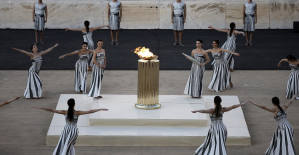"The people who were buried in the large stengravar available in many parts of Europe were closely related to each other. It shows a genetic survey of 24 individuals who were laid to their final resting place under the large boulders that were erected on the island of Gotland, Ireland and Scotland thousands of years ago."
"Across Europe there is in places the big stendösen, remarkable accumulations of large boulders which obviously have been created by people. They are available almost everywhere. Not least in the british isles, in Denmark, along the Atlantic coast down to Portugal and in Sweden."
"– They are very unevenly spread. In Falbygden are a couple of hundred, but just one or two on the island of Gotland, " says Helena Malmström, researchers in arkeogenetik at Uppsala university, to news agency TT."
"Stensamlingarna was a memorial for some of the people who lived in Europe during the so-called third century for about 6 500-5 000 years ago."
"They lived in the stone age, but were farmers not long after the art of tilling the soil had spread to Europe from Anatolia, that is to say, the peninsula in western Asia that occupies the greater part of today's Turkey. And it was at these so-called megalithic tombs in which they buried their near and dear ones. Although it may not always be visible in the day, they were often covered with a "
"– There are great designs that go both above and below ground. Usually, you can find the remains from several individuals, upwards of 50 pieces, in one and the same tomb. We think they took out the dead in the house and placed them sitting on their haunches. Then, after several years, shoveled it away the remains and made room for the new one, " says Helena Malmström."
"this way," she says, some of the burial chamber have been used in several hundred years. For example, the researchers think that Ansarve stendösen on the island of Gotland was used as a burial chamber for more than 700 years. But who were these people? They were friends, the only men or could "
"to get to know more now have international team of researchers, led from Uppsala university, conducted a genetic survey of the genome from a total of 24 individuals from five different megalithic tombs on the island of Gotland, Ireland and Scotland."
"– On the island of Gotland, we have analyzed the remains and dated skeletons from nine different individuals in Ansarvegraven, " says Helena Malmström."
"the Skeletons were dated using the carbon 14 method, and from the bones and teeth extracted to dna. The results, published in the journal Proceedings of the National Academy of Sciences (PNAS), shows that the people buried in the tombs lived between 3 800 and 2, 600 years before our era, that is to say for approximately 5 800 4 600 years ago. But above all it shows the dna analyses that the individuals in each grave were closely related with each other."
"By analysing the genetic material found in mitochondria, which is only inherited on the maternal line, and that which is found on the Y chromosome, which sons inherit from their fathers, had the researchers a more detailed picture of the släktskapsförhållandena."
"In Ansarvegraven on the island of Gotland, the researchers were able in this way to distinguish between first-degree and second-degree kinship, such as parents and children, respectively, the mother-u002Ffarföräldrar and grandchildren. In this tomb they found an example of second-degree kinship."
"In Ireland, however, found several different kinds of kinship, including two examples of a first degree kinship. In addition, between the individuals who had been buried in two different tombs, which is located two kilometers from each other (Listhogilgraven at Carrowmore, respectively, Tomb 1 at Primrose), where a man and his son got to his final rest."
"– over-the-head one can find the relationship is interesting, because you never been able to show it so clearly before. Sure, there have been speculations, but before you know how this is indeed the case, it is just speculation. So is this study also important, " says Helena Malmström."
"The distinctive släktlinjerna and the fact that men are over-represented in some of the graves suggest – according to the research leader Mattias Jakobsson, professor at Uppsala university – that the individuals buried in the megalithic tombs belonged to a conductive layer in a patrilinjärt society that was defined by the fathers and their sons, rather than that they were a random selection of residents."
"There are around 35 000 megaliths in Europe. Most of them come from the younger stone age and the period between the neolithic and the bronze age (copper age)."
"most of The megaliths found in the coastal areas."
"until very recently, researchers thought that the megalithic tombs arose in five different regions in Europe, independent of each other, but that is not the case. The tradition began probably in Brittany in northwestern France for 6 000 years ago, during a period of 200-300 years, and spread then out over Europe, above all through sea voyages."
"Sources: university of Gothenburg, NE."

 War in Ukraine: when kyiv attacks Russia with inflatable balloons loaded with explosives
War in Ukraine: when kyiv attacks Russia with inflatable balloons loaded with explosives United States: divided on the question of presidential immunity, the Supreme Court offers respite to Trump
United States: divided on the question of presidential immunity, the Supreme Court offers respite to Trump Maurizio Molinari: “the Scurati affair, a European injury”
Maurizio Molinari: “the Scurati affair, a European injury” Hamas-Israel war: US begins construction of pier in Gaza
Hamas-Israel war: US begins construction of pier in Gaza First three cases of “native” cholera confirmed in Mayotte
First three cases of “native” cholera confirmed in Mayotte Meningitis: compulsory vaccination for babies will be extended in 2025
Meningitis: compulsory vaccination for babies will be extended in 2025 Spain is the country in the European Union with the most overqualified workers for their jobs
Spain is the country in the European Union with the most overqualified workers for their jobs Parvovirus alert, the “fifth disease” of children which has already caused the death of five babies in 2024
Parvovirus alert, the “fifth disease” of children which has already caused the death of five babies in 2024 Inflation rebounds in March in the United States, a few days before the Fed meeting
Inflation rebounds in March in the United States, a few days before the Fed meeting Video games: Blizzard cancels Blizzcon 2024, its annual high mass
Video games: Blizzard cancels Blizzcon 2024, its annual high mass Falling wings of the Moulin Rouge: who will pay for the repairs?
Falling wings of the Moulin Rouge: who will pay for the repairs? “You don’t sell a company like that”: Roland Lescure “annoyed” by the prospect of a sale of Biogaran
“You don’t sell a company like that”: Roland Lescure “annoyed” by the prospect of a sale of Biogaran Exhibition: in Deauville, Zao Wou-Ki, beauty in all things
Exhibition: in Deauville, Zao Wou-Ki, beauty in all things Dak’art, the most important biennial of African art, postponed due to lack of funding
Dak’art, the most important biennial of African art, postponed due to lack of funding In Deadpool and Wolverine, Ryan and Hugh Jackman explore the depths of the Marvel multiverse
In Deadpool and Wolverine, Ryan and Hugh Jackman explore the depths of the Marvel multiverse Tom Cruise returns to Paris for the filming of Mission Impossible 8
Tom Cruise returns to Paris for the filming of Mission Impossible 8 Skoda Kodiaq 2024: a 'beast' plug-in hybrid SUV
Skoda Kodiaq 2024: a 'beast' plug-in hybrid SUV Tesla launches a new Model Y with 600 km of autonomy at a "more accessible price"
Tesla launches a new Model Y with 600 km of autonomy at a "more accessible price" The 10 best-selling cars in March 2024 in Spain: sales fall due to Easter
The 10 best-selling cars in March 2024 in Spain: sales fall due to Easter A private jet company buys more than 100 flying cars
A private jet company buys more than 100 flying cars This is how housing prices have changed in Spain in the last decade
This is how housing prices have changed in Spain in the last decade The home mortgage firm drops 10% in January and interest soars to 3.46%
The home mortgage firm drops 10% in January and interest soars to 3.46% The jewel of the Rocío de Nagüeles urbanization: a dream villa in Marbella
The jewel of the Rocío de Nagüeles urbanization: a dream villa in Marbella Rental prices grow by 7.3% in February: where does it go up and where does it go down?
Rental prices grow by 7.3% in February: where does it go up and where does it go down? Even on a mission for NATO, the Charles-de-Gaulle remains under French control, Lecornu responds to Mélenchon
Even on a mission for NATO, the Charles-de-Gaulle remains under French control, Lecornu responds to Mélenchon “Deadly Europe”, “economic decline”, immigration… What to remember from Emmanuel Macron’s speech at the Sorbonne
“Deadly Europe”, “economic decline”, immigration… What to remember from Emmanuel Macron’s speech at the Sorbonne Sale of Biogaran: The Republicans write to Emmanuel Macron
Sale of Biogaran: The Republicans write to Emmanuel Macron Europeans: “All those who claim that we don’t need Europe are liars”, criticizes Bayrou
Europeans: “All those who claim that we don’t need Europe are liars”, criticizes Bayrou These French cities that will boycott the World Cup in Qatar
These French cities that will boycott the World Cup in Qatar Basketball: Strasbourg appeals the victory recovered by Monaco
Basketball: Strasbourg appeals the victory recovered by Monaco Top 14: UBB with Tatafu and Moefana against Bayonne
Top 14: UBB with Tatafu and Moefana against Bayonne MotoGP: Bagnaia dominates qualifying practice in Spain and sets track record
MotoGP: Bagnaia dominates qualifying practice in Spain and sets track record Olympic Games: in Athens, Greece transmits the Olympic flame to France
Olympic Games: in Athens, Greece transmits the Olympic flame to France


















